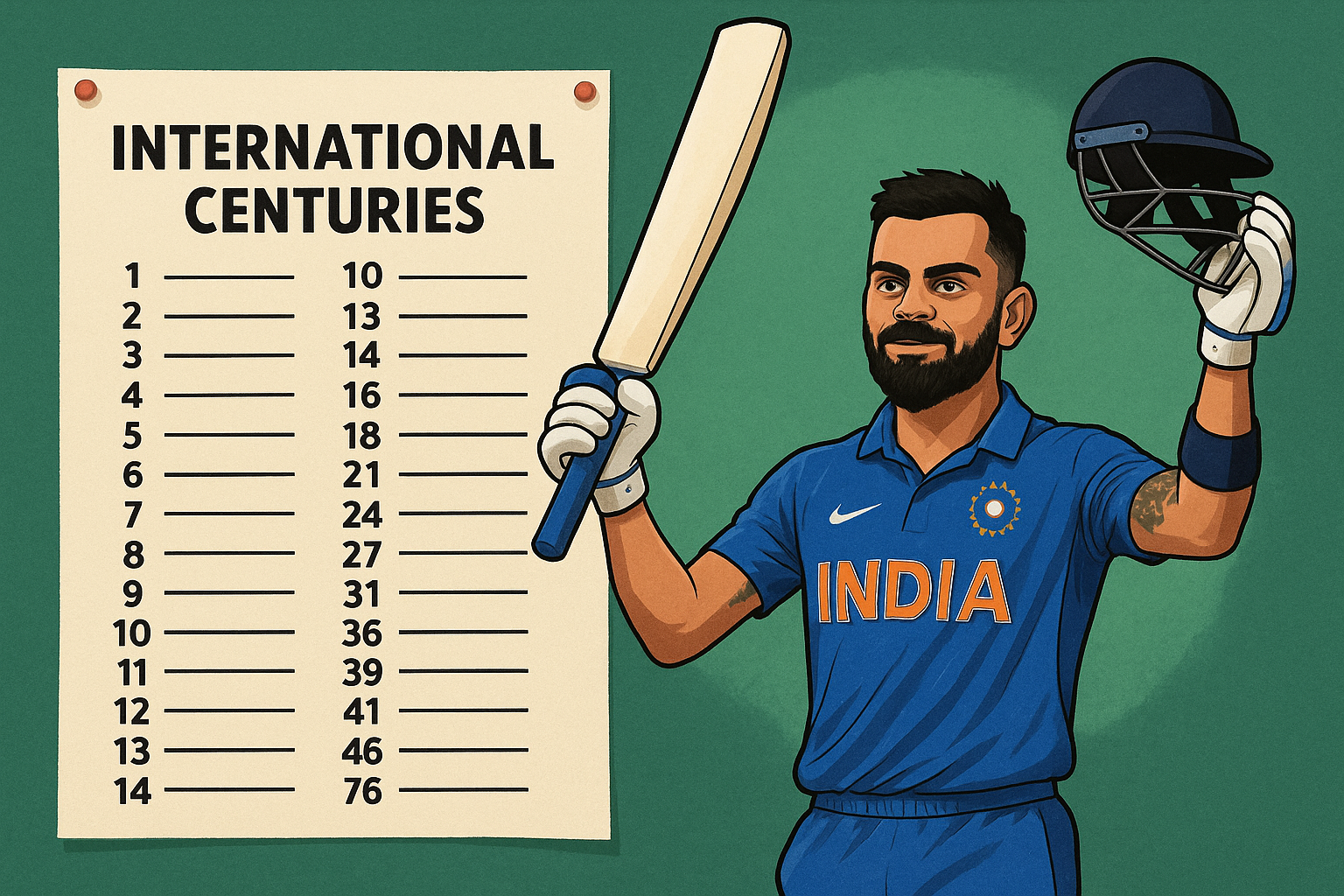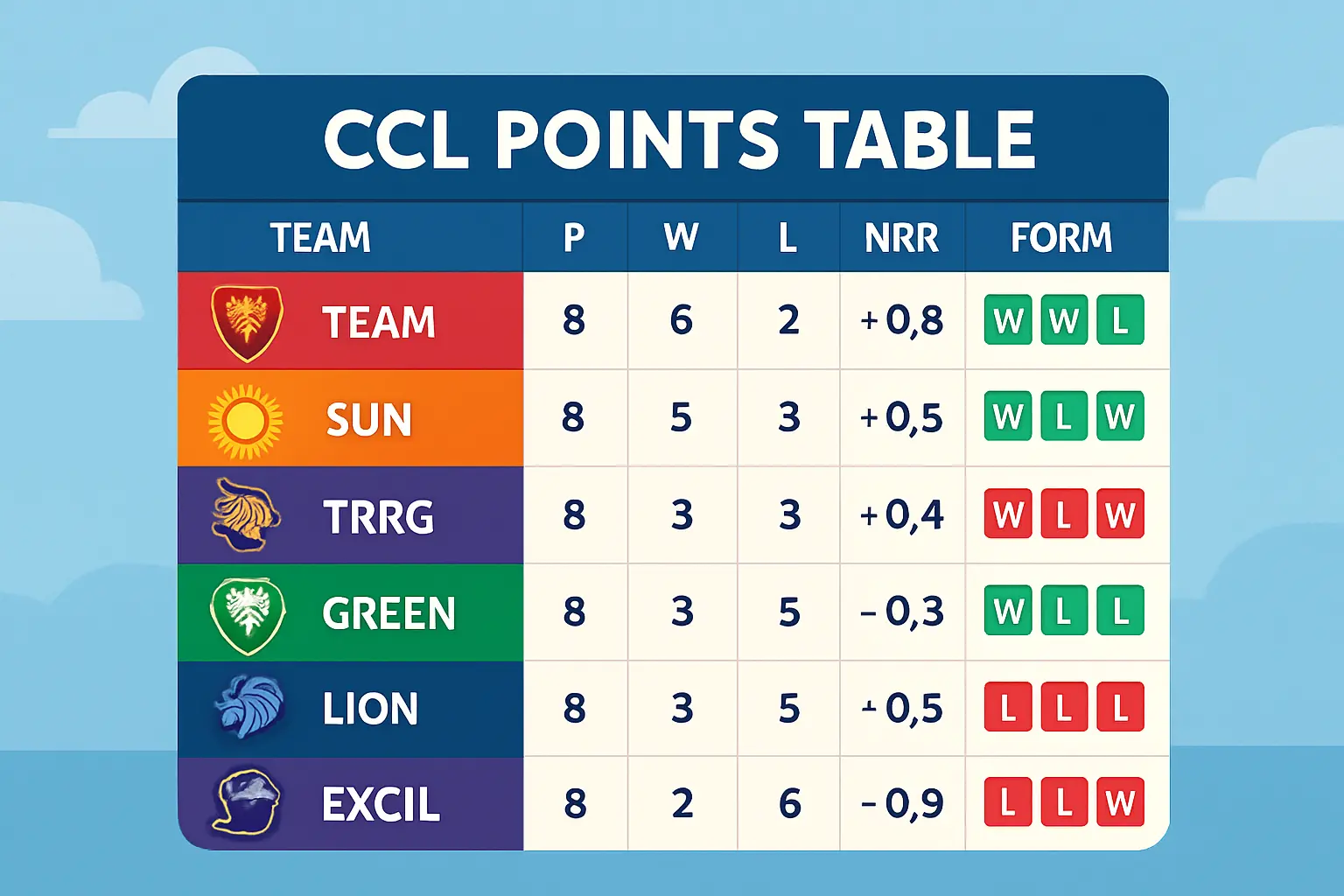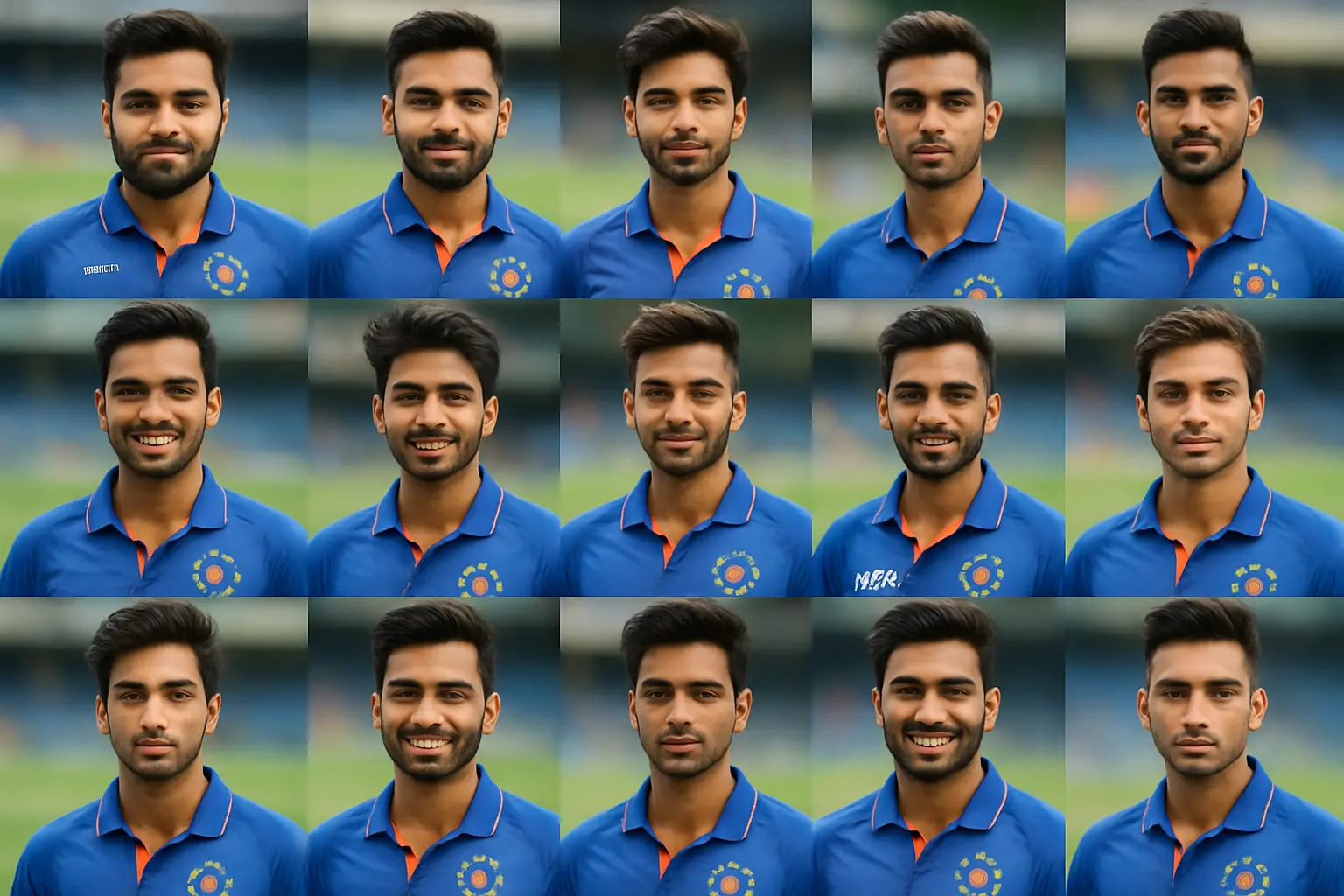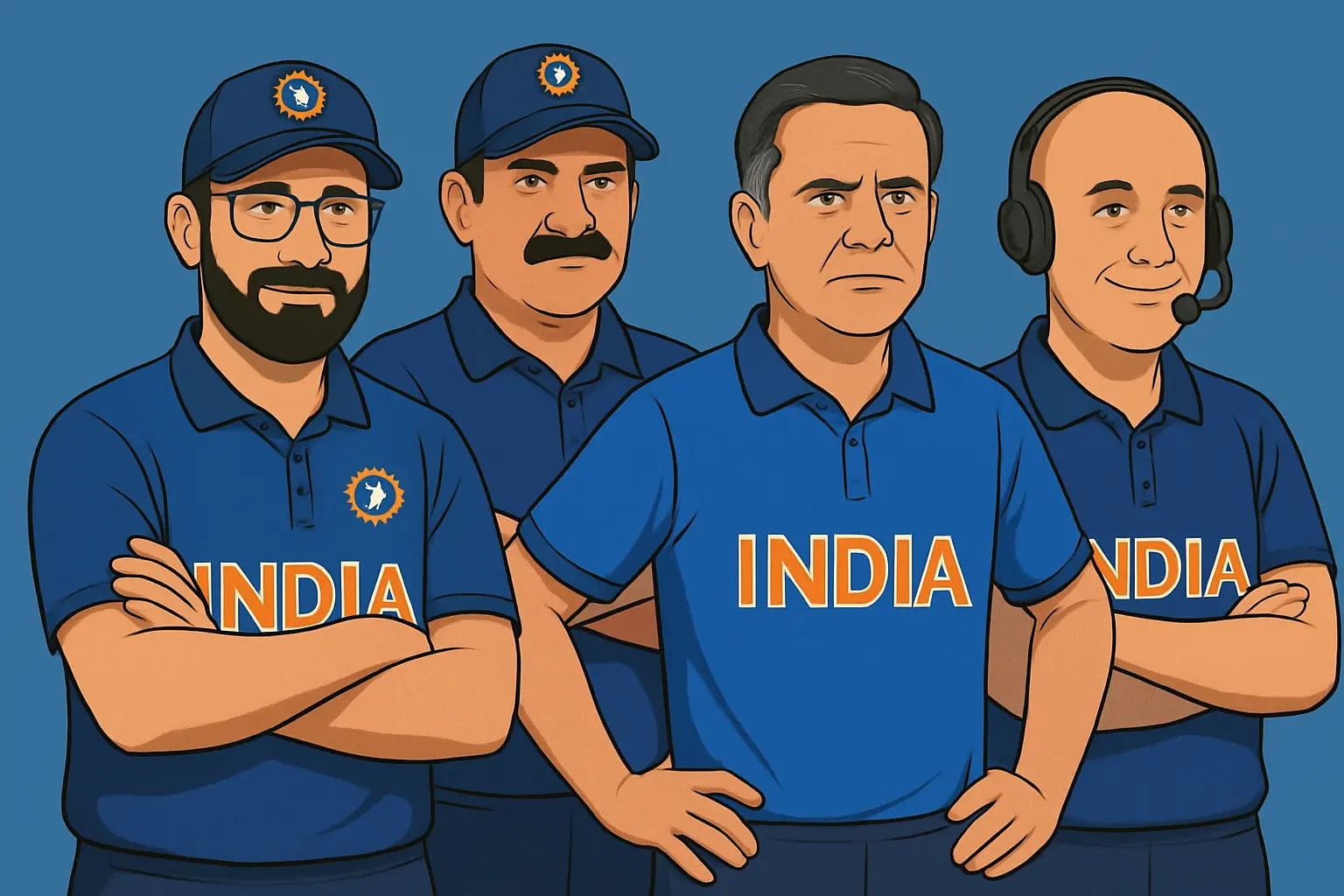There are batting careers that sit happily in the record books. And then there is Virat Kohli’s body of work, an archive of relentless standards and edge-of-seat reliability. His international centuries altered what India—and much of the world—thought possible in white-ball chases and in Test-match tempo. He did it in pressure-cooker nights under lights, in abrasive afternoons across SENA conditions, at the heart of bilious rivalries, in dressing rooms that fed off his pace. The numbers are vast. The detail is richer still.
This is the canonical guide to Virat Kohli international centuries: the complete picture, the context behind the landmarks, and the meaning of those hundreds to matches, tournaments, and eras. It’s written from the press box and from the middle—because with Kohli you always feel close to the clockwork: the running between wickets, the shoulder drops for an extra two, the cover drive that makes cricketers on both teams smirk in shared appreciation.
A quick, essential count up front: Kohli total international centuries stand at 80 across formats—50 in ODIs, 29 in Tests, and 1 in T20Is. That split alone hints at his dual mastery: an ODI centurion without peer and a Test craftsman with seven double-hundreds and a substantial SENA footprint. What follows brings that framework to life.
Latest hundred, and why it felt inevitable
The most recent addition to the pile came on a massive stage, with a packed Wankhede at fever pitch and New Zealand on the other side. A semifinal. A familiar platform. Kohli’s 50th ODI hundred. He didn’t chase that landmark; he constructed it out of match logic—pacing the innings, tearing into the death overs only after the risk curve shifted, trapping bowlers in their lengths. The landmark felt grand because it closed a loop: the player who taught a generation how to engineer ODI totals under pressure sealing the half-century mark for ODI centuries in front of his home crowd.
Quick stat summary (snapshot)
- Kohli total international centuries: 80
- Virat Kohli ODI centuries: 50
- Virat Kohli Test centuries: 29
- Virat Kohli T20I century: 1
- Kohli centuries in World Cup: 5
- Most centuries in ODI chases: record holder (27)
- Highest scores: 254* (Tests), 183 (ODIs), 122* (T20Is)
- Double hundreds in Tests: 7
- Most international hundreds as India captain: record holder
Why this page matters if you’re searching for virat kohli international centuries, virat kohli all centuries, or a kohli international centuries list
You will find lists everywhere. But an expert lens connects each hundred with context—match state, opposition strategy, surfaces, and the way Kohli recalibrated plans mid-innings. Here you get the master inventory and the stories that breathe through it: how a hundred in Perth differs from one in Kolkata; why he is the best we have seen while chasing; and how his Test tempo created brand-new win conditions for India.
The ODI epic: Virat Kohli ODI centuries explained as a craft
Kohli’s ODI batting is a masterclass in production under constraint. He created a template for totals—middle-overs strangulation followed by a late burst—that teams around the world try to replicate, often without the dexterity he has in strike rotation. Most great ODI hundreds have a launch pad: an early read on pace off the wicket, a target against the spinners, a specific seam length to break repeatedly. Kohli’s hundreds are different because he writes those launch pads into existence even when they’re not offered.
He plays No.3 as a tactical engine room, not as a placeholder. He has hundreds as the first-drop rescuer after an early wicket and as the platformer after a fast start. He shifts from 80 off 85 to 110 off 105 to 130 off 120 and it never looks hurried. The movement on the scorecard feels…quiet. The bowler’s field is always a step late. He turns 1s into 2s. He turns caution into exhaustion for the opposition.
Definitive ODI hundreds and why they stand apart
- 133* vs Sri Lanka, Hobart: A target, a time cap, and a track that skidded on. Kohli engineered a chase that felt like a T20 done at ODI scale—one of his finest acceleration scripts, dismantling Lasith Malinga’s endgame yorkers with deep-in-the-crease geometry and explosive wrists. That unbeaten 133 was the night his ODI chasing reputation stopped being a statement and became an era.
- 183 vs Pakistan, Mirpur: The chase was steep, the pressure atmospheric. He dominated both seam and spin with field-reading that was supernatural. The strike rotation against Ajmal was textbook; the assault on anything back of a length felt inevitable. A high-sovereignty knock in a rivalry game.
- 100* vs Australia, Jaipur: Not all tons are heavy in balls faced. This was the ODI version of a jailbreak sprint—chasing a monster score and ripping 100 off 52 balls. One of the purest displays of pace-through-the-chase in modern ODI cricket.
- 154* vs New Zealand, Mohali: An anchor’s hundred with a finisher’s ending, Kohli at his most rounded. A hallmark innings: minimal risk windows early, maximal pressure late, immaculate running in tandem with MS Dhoni.
- 160* vs South Africa, Cape Town: Classic anti-seam discipline into anchored dominance. The hallmark here was relentlessness on a tricky pitch; South Africa rarely looked like they had a length he could not manipulate.
- 122* vs Pakistan, Colombo: A statement in control. His “second gear” in big India–Pakistan games is a genre by itself. Seamers’ back-of-length channel erased, legside manipulation relentless.
- 117 vs New Zealand, Wankhede (semifinal): A coronation in the city of champions. The landmark 50th ODI hundred that still served the game situation perfectly—no vanity, only ruthless pacing.
- 157* vs West Indies, Visakhapatnam: High control, high fluency, minimal false shots. When Kohli has both sides of the wicket opened and the running patterns working, it often ends in unbeaten.
- 166* vs Sri Lanka, Thiruvananthapuram: An annihilation; the innings where everything clicked—shape at contact, lofted drives, and the sort of late-overs mania that looks unfair on a good day.
- 115 and 129, assorted home chases: Multiple instances where he turned a par chase into a procession, the sort of “nothing to see here” knock that says as much about excellence as the flashy ones.
Virat Kohli ODI centuries list—how to read it like a pro
A long numerical list is the easy part. The real understanding lives in splits:
- First innings vs second innings: His ODI second-innings log is the benchmark for the format. More hundreds chasing than batting first, and a record number in successful chases. The lesson is not just about appetite; it’s about clarity. He outsources nothing to chance: fields are mapped, bowlers tagged, high-value areas hit on repeat.
- Home, away, neutral: Kohli’s ODI centuries travel. He has done it in South Africa, Australia, England, and across Asia in neutral conditions. The character of the hundreds changes with the air and the soil. In Asia, you see the sweep scarcity, the back-foot punch, the ability to hit with wrists through midwicket. In SENA countries, he moves later, head still, letting the ball come to him, compiling until the leap.
- As captain vs non-captain: The weight of leadership did not blunt his numbers; it sharpened them. He stacked up a record tally of international hundreds as India captain. The ODI piece of that was a sustained period of clarity in vision: be the first responder and the last hitter, all while managing the batting order and bowling changes.
Virat Kohli Test centuries—tempo, range, and a SENA résumé
Strip away the white-ball glow and you meet a Test craftsman with classical control and modern intent. Kohli’s Test hundreds often sit on two pillars—discipline in channel outside off, and tempo control after fifty. It’s the second that changed games. For years, India’s Test batting often settled for safety after breaching 50; Kohli turned fifty into a launchpad and created the oxygen that his spinners and quicks used later.
Difficult conditions? He has a Test hundred at Adelaide where he learned more about himself than in a dozen soft runs anywhere else. He owns a century at Perth, against pace and venom. He wrote a sculpted 153 at Centurion, a lesson in wobble-seam survival. He replied to the short ball flood and the fifth-stump obsession with hard hands, then softer ones. He closed series at home with double hundreds that were not vanity numbers—they were innings of strangulation, pushing the lead from safe to match-ending.
The seven double hundreds form their own portfolio. They came in different conditions across various opponents; nearly all looked like he had more in him when he declared or was dismissed. The 254* at Pune was not a marathon; it was an autopsy on length. The 235 in Mumbai held shape, flow, and brutality against a very capable attack. Even his 136 in a pink-ball Test at Eden Gardens was an essay on plan-shifts under lights.
SENA centuries in Tests—the honest badge
- Australia: A generous handful, including twin tons at Adelaide as captain, the Melbourne and Sydney masterpieces, and a muscular ton at Perth. The way he played Nathan Lyon on rough tracks and the mechanism against back-of-length high pace tells you how he thinks runs into being.
- England: A champion-level reply at Edgbaston and a match-seizing hundred at Trent Bridge. He survived the moving ball by leaving better, lining up later, and banning the flashy drive early. When he earns square-of-the-wicket runs in England, you know he has control.
- South Africa: A pair of outstanding knocks—Centurion especially—earned by meeting the seam with stillness and backing his back-foot punch. If you’ve watched him scrap at SuperSport Park, you’ve seen composure redefined.
- New Zealand: The one member of SENA where he has not cashed a Test hundred yet, a quirk that owes as much to sample size and conditions as anything else.
Virat Kohli T20I century—one night that read like a thesis
The format once seemed designed to deny him the triple-digit landmark—he had collected a small museum of unbeaten eighties and nineties. Then he opened the batting against Afghanistan in Dubai and solved it in one night. That 122* was a T20I manual: no slog shape, just classical arc plus ruthless cardio between the wickets. He picked his big overs, protected his match-ups, and lifted the rate without chancy leaps. It felt inevitable only after it happened.
Kohli centuries in World Cup—narrative and numbers
World Cups bring their own gravity. Kohli owns five World Cup centuries, and each belongs to a different shelf.
- The first arrived in an opening game, a cool hundred that calmed dressing-room nerves. The innings was measured, crisp through the covers, and respectful of start-stop phases.
- The hundred against Pakistan in a global tournament opener lit a fuse. Both teams were electric, the surface true, the crowd seismic. Kohli’s calm under that neon glare was extraordinary.
- The set of three in the most recent home World Cup was an epic of control and purpose. A hundred against Bangladesh built on a base and allowed India to press the NRR accelerator. The landmark 49th ODI hundred against South Africa at Eden Gardens felt like a centurion stretching out in perfect conditions. And the semifinal 117 at Wankhede was both a personal milestone and a masterclass in knockout batting.
Virat Kohli centuries by country—the map behind the legend
- India: His home record is a fortress, and not just on white-ball belters. The Test double hundreds around the country show a batting brain that reads the slow deterioration of pitches and plans accordingly: tire the quicks, spread the fields, and then extract maximum value from spin-prone tracks. White-ball hundreds at home often look inevitable; they’re anything but. He builds them with risk budgets and running lanes.
- Australia: A favorite hunting ground. ODIs there have this special Kohli sheen—gliding through covers on true bounce, and punishing anything back of a length. Test-match hundreds in Adelaide and Perth sit among his most precious.
- England: ODI hundreds in England are built differently—back-foot timing with minimal flourish, eyes over the ball, wrists uncoiling late. Test-match tons there are rarer and thus cherished, carved through a disciplined leave and guarded drives.
- South Africa: ODI and Test centuries came with trademark discipline: watching the seam, killing the fifth-stump temptation, and then letting the hands free once the ball aged. Cape Town in ODIs, Centurion in Tests—both are innings with match-winning proof.
- Pakistan and Sri Lanka (various venues, including neutral): Against Sri Lanka, he has an assembly line of hundreds; against Pakistan, every ton is a chapter in the lore. The 183 is part of cricketing pop culture now.
- West Indies, Bangladesh, UAE: Plenty of runs. Against West Indies he has stacked up a remarkable count. In the UAE, Ahmedabad, Kolkata, Pune, and elsewhere, his white-ball blueprint holds up in any light.
Kohli centuries in chases—the signature
The ODI chase is cricket’s purest pressure cooker. Kohli’s response? A record tally of hundreds in chases, most in successful pursuits. He is the ultimate closer because he treats each chase like a living organism. The early overs are about information: bounce, swing, field appetite. Then comes the patterning: he chooses a bowler to harvest, a fielding ring to pressure, an over to steal. By the time the asking rate looks dangerous to you, it looks ordinary to him. A hundred chasing inside the powerplay window, a hundred built after a rebuild—he has done both, repeatedly.
One of the secrets behind the chase supremacy is how he and his partners move. Watch his body language between balls: a quick glance at the field, a soft run-up to the striker’s end for a non-existent single to stress the infield, the constant conversation with the partner. It’s a control room out there, and every hundred in a chase looks like a plan executed with discipline.
Kohli centuries at home and away—the split that shows a complete player
This is not a bat who inflated numbers in one hemisphere. The away-venue hundreds cover fast bounce and dark movement; the home-venue hundreds cover low bounce and late spin. ODI away centuries in South Africa and Australia established repeatable methods: build through the middle overs without exposing the stumps, trust the late flourish, and ensure the non-striker is a running partner. Test away hundreds in SENA countries took patience, a better leave, and a commitment to play late. None of that is copy-paste from one place to another; he wrote new templates for new geographies.
Kohli centuries at Wankhede and Eden Gardens—the two cathedrals
- Wankhede: His 50th ODI hundred at this venue was pure theatre. Wankhede rewards elegant back-foot play and late hands; he produced both. Earlier at Wankhede, in various formats, he has married the venue’s pace with his hunger for the big night. It’s a ground that turns milestones into moments.
- Eden Gardens: A century under lights with the pink ball reads like a case study in adaptation, and a World Cup hundred there was a serenity project. Eden’s large pockets and wicked evening breeze suit his appetite for twos and the crisp punch through extra-cover. He seems to hear the stadium breathe with him.
Opposition lens—virat kohli centuries vs australia, england, sri lanka, pakistan
- Australia: Few batters needle Australia the way Kohli does. The contest is personal but clean. Hundreds in Adelaide, Melbourne, Sydney, Perth, Hobart, Jaipur—pick a setting and you’ll find one with edge, intensity, and perfect time-of-attack. Against their white-ball attacks, he has neutralized the short-and-wide ploy by late cuts and glides, then punished the attempt to cramp him with those wrists.
- England: The Test discipline sharpened there. In ODIs, he punishes the short-of-length seamers, then picks off spin with angle rather than slog. A Kohli hundred against England often looks like a blueprint you could teach.
- Sri Lanka: His most plentiful opponent in ODIs. The hundreds vary—from brutal to artful—but the trendline is his complete ownership of their seam lengths and a near-miraculous ability to withdraw risk when a collapse threatens.
- Pakistan: The emotive rivalry enhances the weight of each run. The 183 in a chase sits with the format’s greatest; the Colombo excellence stands beside it in modern memory. Against their high-pace and quality spin, he maps out quiet ones and big overs with a calm most batters would beg for.
Kohli hundreds across formats—what they tell us about the batter’s core
- Tests: Patience, then brutality. He doesn’t slog to elevate the rate. He accelerates by closing his stance slightly, choosing a seam to target, and harvesting a zone—midwicket or cover—until the opposition breaks.
- ODIs: Choreography. He walks you into fields that suit him and then runs you to death. He could hit a boundary where you expect a single and run a two where you saw none.
- T20Is: Range hitting is there; what you remember is the command over tempo. Even at 122*, there were no wasted swings. He cut risk by manipulating angles.
Kohli vs Sachin centuries comparison—two giants, two eras
Comparisons between Kohli and Sachin Tendulkar can be juvenile if reduced to totals. But used well, they show how the game evolved.
- Role in ODIs: Tendulkar opened through long stretches, setting up platforms and sometimes batting teams out of games in the first half. Kohli did it at No.3, often after one of the openers fell, with chases defined by his presence. The value of a hundred under lights while chasing changed with DLS, fielding restrictions, and modern powerplay dynamics. Kohli mastered that world.
- Volume vs velocity: Tendulkar built mountainous volume across two formats and then into T20. Kohli added more T20I bandwidth and ODI velocity—reaching the half-century mark in ODI centuries faster than anyone.
- Tests: Sachin’s longevity and range in Tests is unmatched over decades. Kohli’s clusters of double hundreds and SENA resilience show a different kind of dominance—less on aggregate career span, more on match-tilting tempo and finishing power.
Most international centuries kohli vs tendulkar—the headline truth
The chase is meaningful, and the conversation will always live. But a more interesting lens is conversion: once they get past fifty, how often does it become a hundred? Kohli’s conversion rate in ODIs is otherworldly among modern greats. Sachin’s Test conversion is a paragon from a different time. The right conclusion is boring, which makes it true: both are essential, the context for their centuries different, the difficulty curve unique, and both singular in their peaks.
Kohli vs Rohit centuries comparison—contrasts that complement
Rohit Sharma’s ODI centuries are explosively front-loaded—he can go from 30 to 130 faster than almost anyone in the format, and his big daddy hundreds (well into the 150s and 200s) give India match-dominating cushions. Kohli’s ODI hundreds are pressure tranches, built on probability control and meticulous running. Put them together and you understand why India’s white-ball batting has often felt complete: one bat to open the ceiling, one to hold the floor.
Kohli vs Babar centuries comparison—generational dialogue
Babar Azam’s batting is a joy in its balance; his ODI and Test figures are formidable. He plays the off-side with princely command and loves the orthodox. Kohli’s centuries, especially in chases, are a masterclass in doing the right thing for the game state over and over. The comparison works only if you let each be themselves: Babar’s aesthetic precision against Kohli’s problem-solving relentlessness. Both have very high ceilings; Kohli’s has been tested longer and under sharper spotlight in knockout pressure.
Fastest to 50 ODI centuries—why the pace matters
Kohli reached 50 ODI hundreds at a clip that belonged to the modern tempo he helped define. The rate is not just a statistic; it represents durability of method. Teams prepared for him for years, yet he found thousands of runs in the same zones with near-identical setups—showing that if you control contact point, bowlers cannot live outside your plans for long.
Fastest to 70 or 80 international centuries—understanding the “fastest” tag
“Fastest” is a loaded word. It compresses era, formats, conditions, and match contexts into a single timer. Kohli’s race to the high-seventies of international hundreds was powered by unparalleled ODI scoring and a Test phase filled with double tons. You can nitpick the calendar math; what you cannot deny is the sustained intimacy with three figures across formats while carrying heavy responsibility in the batting order and often the captaincy.
Kohli century conversion rate—the hidden god-stat
Among premium ODI batters, his conversion once past 50 sits in a tier of its own. That is not luck. It’s shot selection after fifty. It’s refusal to give away phases. It’s the cold decision not to chase the wrong bowler for the hundred and to choose the right over to cross three figures in service of the chase or the team total. In Tests, the conversion showed up in the double hundreds bonanza, when he transformed “big” into “massive” often enough to decide entire series.
Most centuries in ODI chases—owned by Kohli, defined by process
The idea of “chase pressure” is fuzzy until you watch him bat. Then it becomes anatomy. He lets the run rate float in the early middle overs and pulls it back without noise. He takes the living room out of the opposition captain’s plans by turning off their favorite fielders. When the crowd feels desperate, he is two overs away from finishing it. That’s how you stack a record number of ODI hundreds in chases.
Most centuries as India captain—what the badge did to the bat
The captaincy chapter is a study in how responsibility can sharpen a great player. He stacked international hundreds as captain at a historic rate, and those centuries were often the cleanest in method. As leader, he didn’t cede definition of the innings to anyone else. He walked in early by design, stood there long, and moved India’s scoring gravity toward his choices. Leadership looked like runs, not just field settings.
Kohli hundreds when chasing target—patterns you can spot
- Early overs: recces and net-run-rate tranquility; not many big swings.
- Powerplay exit: a flurry of doubles, nothing aerial away from the slot.
- Middle overs: squeeze the off-side ring; pull, glance, glide with an emphasis on twos.
- Death overs: calculate the hundred’s pathway inside the larger equation—if the target demands ruthlessness, the hundred happens by accident; if the task allows, he crosses the mark and then detonates.
Kohli hundreds in ICC tournaments—the reputation
Knockout batting. Opening-game composure. Big opposition. He has done all three. Hundreds in global tournaments are not just about how many; they’re about when. A semifinal at Wankhede. An opener against Pakistan. A large one against South Africa under a cloudless sky. These are high-noise games where many greats blink. He rarely does.
Centuries in winning causes vs losing causes—the team impact
The overwhelming majority of Kohli’s hundreds come in wins. That is both selection bias (teams that produce hundreds often win) and characteristic of his batting. He does not give you hollow runs. His ODI hundreds in particular clip so closely to the scoreboard demands that by the time he gets there, India has already turned the corner. His Test hundreds often arrive in the kind of innings that create unassailable leads. When he crosses three figures, the opposition’s margin for error usually evaporates.
First innings vs second innings—two different beasts
- First innings in ODIs: pattern-setting. He often takes longer to reach the hundred, then finishes with a flourish that vaults India beyond par.
- Second innings: pace control. He hides the hundred inside the chase mechanics; the landmark is a by-product.
- In Tests: first-innings hundreds come with more leaves and inside edges survived; second-innings hundreds carry more risk management and field manipulation, often to set up a declaration.
Kohli as opener vs No.3
He is essentially a No.3 batter in ODIs and Tests. That slot is the heartbeat of India’s white-ball bookings. The T20I hundred came as an opener, a role he can ace in short bursts because of his array against new-ball swing and his capacity to hit safe, early boundaries. But the bulk of his centuries—and his identity—rest at No.3, where he controlled games for a decade plus.
Kohli century drought and comeback—the human arc
Every king has lean months. Kohli’s quiet patch was long enough to birth narratives. He scaled back. He dug deep. He returned to that T20I monolith in the desert, then stacked ODI hundreds again, peaking with the 50th in a knockout. The lesson was not about magic; it was about method rediscovered. That is why his centuries after the quiet spell felt both fresh and familiar—same orthodoxy, restored confidence, shot selection cleaned up, trigger movement tidied, and the old running hunger unchained.
Virat Kohli centuries by year—the pattern without the calendar
If you draw a sparkline of his career, you will see three clear zones. A burst of early hundreds while India’s white-ball engine was changing shape. A long, incandescent peak where hundreds arrived like clockwork and ODI chases felt pre-ordained. And a period of recalibration followed by a resurgence. The rate changed; the method survived. That is how a modern great ages.
Virat Kohli test centuries list—fine print you should know
- Many home double hundreds came against very decent attacks on not-so-flat decks. The footwork against spin was less about big strides and more about early pick-up of length plus a full bat face.
- The Adelaide and Perth hundreds weren’t just about strokeplay; they were about grit after bruising sessions. The Centurion masterclass against seam movement was pure determination.
- The pink-ball Eden Gardens hundred showcased adaptability—a different ball, twilight, and pace off the pitch. He planned it as if it were a new format inside the Test.
Virat Kohli ODI centuries list—context beyond the runs
- Big totals under lights hide in the middle overs. That’s where he wins them.
- His fastest ODI hundreds reveal a selective explosiveness; he can move into full white-ball mayhem when the equation demands.
- Look at his hundreds across series rather than single games. You’ll see how he can dominate a set of bowlers across varied venues with a single, unbroken plan.
A lean, factual summary table
Format split and milestones
- International centuries total: 80
- Tests: 29 (highest 254*, seven double hundreds)
- ODIs: 50 (highest 183, most hundreds in chases, five in World Cups)
- T20Is: 1 (highest 122*)
- Most international hundreds as India captain: record tally
- ODI chase hundreds: record tally
Kohli centuries in SENA countries (Tests)
- Australia: multiple, including twin tons at Adelaide, big knocks in Melbourne, Sydney, Perth
- England: a pair of high-class tons, including Edgbaston and a series-shifting knock at Trent Bridge
- South Africa: two, highlighted by the Centurion masterwork
- New Zealand: the missing Test hundred, a minor quirk
Kohli centuries in World Cup—five that shaped campaigns
- Opening-game hundred in a global cup opener
- Hundred vs Pakistan in a tournament opener
- Three in the most recent home campaign, including a semifinal epic at Wankhede
The tactical DNA: how the centuries keep happening
- Pre-contact stillness: Against high pace and moving ball, his head barely rocks. That’s how he keeps a large contact zone alive.
- Angle manipulation: Flicks to fine leg, glides behind point, checks to long-on—he uses the whole square to engineer easy runs.
- Running: The best runner between wickets of his generation—every partner’s scoring rate climbs with him.
- Match-up literacy: He knows exactly which bowler to take down in which phase and which to absorb until the next over.
- Risk budget: A hundred means nothing if it doesn’t serve the game state. He preserves wickets like a Test bat and spends them like a finisher.
Virat Kohli centuries by venue and opposition—the subtle textures
- Delhi, Pune, Nagpur: Indian cities where he’s turned starts into match-ends, leaving bowlers and captains bereft of new ideas after fifty.
- Kolkata (Eden Gardens): An amphitheater that suits his class. Big nights, wise crowds, and the breeze that hugs the covers region—it’s a love story.
- Mumbai (Wankhede): Heavy pressure nights and celebratory finishes. The city demands a sense of occasion; he brings it.
- Adelaide, Melbourne, Sydney: Australian venues that give bounce and consistent carry. His hundreds there feel classical, the cover drives leaving their own afterglow.
- Centurion, Cape Town: pared-back elegance. Anything loose goes; anything fourth-stump is met with suspiciously late hands.
How many international centuries does Virat Kohli have—what the count means
Eighty is a high hill, and it masks how much discipline lives behind that summit. There’s no gimmick here. Hundreds arrive because he respects the clock of an innings and the geometry of fields. For all the large claims that swirl around the number, the essence of Kohli’s hundreds is small decisions repeated—do not chase wide, do not open the bat face too early, keep your base, keep the twos alive, choose your over to leap.
Kohli century records updated—the living scrapbook
Each passing season adds another annotation to the scrapbook. The ODI ledger already has the biggest headline: he pushed the idea of the No.3 ODI chaser into mystical territory, then locked it with the landmark 50th. The Test book shows double hundreds stashed across series and the SENA-earned knocks that keep selectors sane and bowlers honest. The T20I page contains one magnum opus that reads like a graduation ceremony.
What separates Kohli’s centuries from the merely excellent
- Repeatability: Different pitches, same method with contextual tweaks.
- Chasing: He drags the chase to a place where out-of-window panic doesn’t exist.
- Fitness: The running game needs lungs and legs; he’s kept both elite.
- Pressure proofing: Bigger the night, smaller the pulse. His shot choice at 95 in a knockout looks like his shot choice at 15 in an opener.
Low-to-medium competition storylines worth your notebook
- Kohli centuries in SENA countries breakdown: reveals the ingredients of an away Test masterclass.
- Virat Kohli centuries in chases analysis: the primer for every white-ball coach.
- Kohli centuries by year graph: the “peaks and troughs” map that shows recalibration rather than decline.
- Virat Kohli centuries as captain vs non-captain: leadership sharpened, not blunted, his run-making.
- Kohli centuries in knockout matches: a clutch dossier.
A selective, expert-listed album of landmark innings
Tests
- Adelaide 116: A first Test hundred in a cathedral of batting; strike of validation.
- Adelaide twin tons as captain: Audacity against a high-grade attack, with fields clawing at him; he climbed anyway.
- Melbourne 169 and Sydney 147: Big, honest runs on honest decks; hungry, tireless.
- Perth 123: The hundred every subcontinental batter wants in their bag; pace, bounce, and bruises included.
- Centurion 153: A technical masterclass against seam-shaping spells; patient, then paralyzing.
- Pune 254*: Surgical. An innings that bent a series toward India by removing all ambiguity.
- Mumbai 235, Delhi 243, Nagpur 213, Hyderabad 204, Indore 211: A symphony of double hundreds that closed out matches by making bowls of runs that opposed teams couldn’t see the bottom of.
- Kolkata 136 (pink ball): New ball, new light, same clarity.
ODIs
- Hobart 133*: The chase that critics quote first when they’re being kind.
- Mirpur 183: The one that sits on T-shirts, posters, and the mental walls of those who bowled that night.
- Jaipur 100* off 52: A sprint conducted with a surgeon’s hands.
- Mohali 154*: A chess game disguised as a batting card.
- Cape Town 160*: Relentless precision on a deck where par was lower; he ignored par and set a new one.
- Visakhapatnam 157*: Unbeaten, inevitable.
- Colombo 122*: When shape meets mood against elite opposition, the game falls away.
- Wankhede 117 (semifinal): A crown placed at the perfect time and place.
- Thiruvananthapuram 166*: The edges of destruction; a celebration of staying in shape to hit late.
T20Is
- Dubai 122*: Milestone night; a hymn to timing and discipline under neon.
Virat Kohli centuries by opposition—the pulse
- vs Australia: He invites the contest and leaves with the points. Long spells of concentration with sudden, bracing acceleration.
- vs England: Patience first, then the stylish unspooling.
- vs Sri Lanka: Ruthless efficiency—he knows the attack patterns and preempts them.
- vs Pakistan: Composure that doesn’t crack; theatrics purely from the ball meeting the middle.
Kohli centuries after the quiet spell—the comeback manual
A rethink of trigger movements, a more decisive off-stump leave in red-ball, a willingness to bat first up in a T20I to unlock the powerplay, and the restoration of his middle-over ODI cruising speed. The comeback hundreds were not louder; they were purer. He removed noise. And once he got a couple under the belt, the shoulders dropped, the wrists loosened, and the landmarks took care of themselves.
If you are tracking virat kohli hundreds across formats—the closing notes
- ODI: A generational peak that changed what chasing meant. Fifty ODI hundreds is not just a round number; it’s a new ceiling for an old format.
- Tests: A compelling portfolio with monster home doubles and proud away badges in Australia and South Africa, and a pair in England that demanded perfect technique.
- T20I: One glorious star that confirms the range was always there.
Why the dataset matters: a note on sources and method
The most reliable numerical scaffolding for kohli international centuries list comes from ESPNcricinfo’s Statsguru pages and the official scorecards carried by Cricbuzz and ICC match logs. The way to read those numbers like an analyst is to attach them to match state: what did the innings change? how did he pace it? which bowlers did he target? That’s where the story lives.
Conclusion—why these hundreds still feel urgent
We can catalogue, compare, and debate. We can erect leaderboards and polish badges: most centuries in ODI chases, fastest to 50 ODI centuries, most international hundreds as India captain. All of that is real. But the reason Virat Kohli international centuries still feel like live sport rather than history is the sensation you get when he begins to pull a chase toward himself—the restless singles, the last-second turns for two, the refusal to take the bait outside off, the little look he gives a teammate when a seam bowler misses his length. A Kohli hundred is not an isolated masterpiece. It is part of an ongoing conversation with the sport about pressure, probability, and poise. And, yes, it usually wins the game.
Appendix: compact comparison table
- Total international centuries: 80
- ODI centuries: 50 (record number in chases; five in World Cups; fastest to the 50-mark)
- Test centuries: 29 (seven doubles; significant SENA presence)
- T20I centuries: 1 (as opener; 122*)
- Highest scores: Tests 254*, ODIs 183, T20Is 122*
- As captain: record tally of international hundreds
- Venues of special note: Wankhede, Eden Gardens, Adelaide, Perth, Melbourne, Sydney, Centurion, Cape Town, Pune
- Opposition highlights: Australia, Pakistan, England, Sri Lanka
This is the full portrait, not just a ledger. If you came looking for virat kohli international centuries with a clean, annotated lens, keep this page bookmarked. Every new hundred will slot in here—not just as a number, but as a story with teeth.











